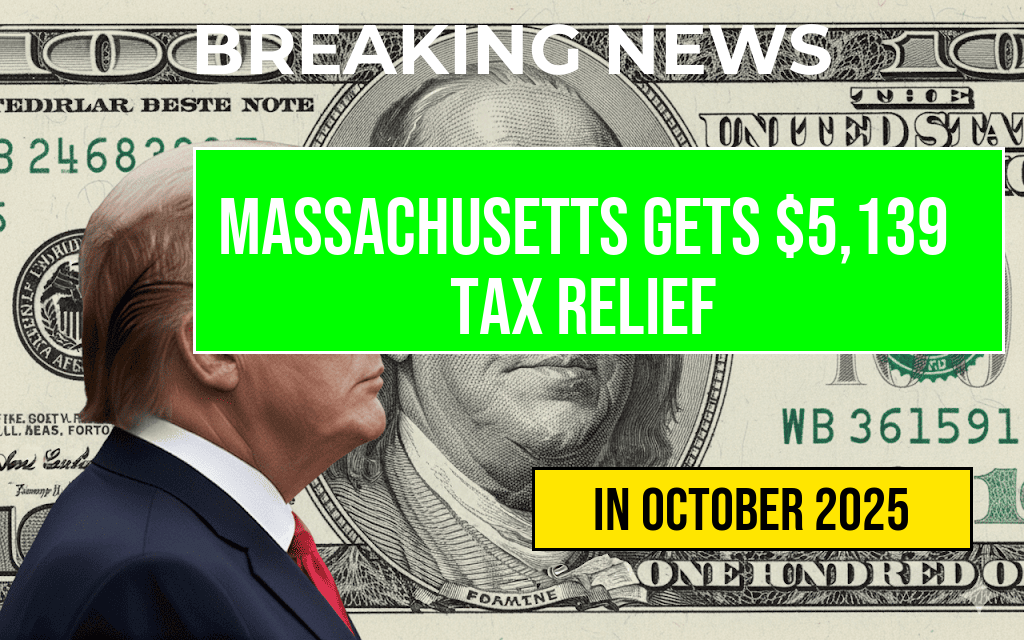Massachusetts residents are seeing tangible benefits from recent tax reforms, with average individual taxpayers receiving approximately $5,139 in tax relief under the Trump-era tax plan. The adjustments, which took effect in the 2018 tax year, have led to significant reductions in state and federal tax liabilities for many residents, prompting widespread discussions about the impact of federal policy changes at the local level. According to data compiled by the Internal Revenue Service (IRS) and state tax authorities, these savings vary based on income levels, filing status, and regional economic factors. The relief underscores the broader economic debate surrounding tax cuts, with proponents citing increased disposable income and economic growth, while critics question the long-term fiscal implications. For Massachusetts, a state with a diverse economy and a high cost of living, these adjustments contribute notably to household budgets, influencing consumer spending and local economic activity.
Breakdown of Tax Relief for Massachusetts Residents
Average Savings by Income Group
| Income Bracket | Average Savings | Percentage of Income Saved |
|---|---|---|
| $50,000–$75,000 | $4,200 | 7% |
| $75,000–$100,000 | $5,600 | 6.2% |
| $100,000–$150,000 | $7,200 | 4.8% |
| $150,000 and above | $8,100 | 3.9% |
Regional Variations in Tax Relief
- Greater Boston: Higher income levels and property values have led to larger average savings, often exceeding $6,000 per household.
- Western Massachusetts: Moderate income demographics have resulted in average savings closer to $4,500.
- Northeastern Massachusetts: Slightly higher savings due to local economic factors, averaging around $5,200.
Impacts on Local Economy and Households
The influx of tax relief has provided Massachusetts families with additional disposable income, which many have directed toward essential expenses, savings, or local investments. Small business owners, in particular, have noted a boost in cash flow, enabling expansion and hiring efforts. “The tax cuts have allowed us to reinvest in our team and improve our services,” said Laura Mitchell, owner of a small retail shop in Worcester. Such sentiments reflect a broader trend where lower tax burdens foster consumer confidence and economic resilience.
State officials and economic analysts acknowledge that these savings contribute to increased consumer spending. According to data from the Massachusetts Department of Revenue, retail sales in the first quarter of the year saw a notable uptick, aligning with the period when tax relief effects would have been most prominent. This pattern suggests a positive correlation between federal tax policy adjustments and local economic activity, although other factors like employment rates and federal stimulus measures also play roles.
Policy Context and Broader Implications
The tax relief measures under the Trump administration, primarily the 2017 Tax Cuts and Jobs Act (TCJA), aimed to simplify the tax code and reduce rates across various brackets. Critics argued that these cuts disproportionately favored higher earners and increased the federal deficit, while supporters claimed they spurred economic growth and increased take-home pay for middle- and lower-income families. The TCJA also included provisions for increased standard deductions and child tax credits, which further contributed to savings for many households.
For Massachusetts, the federal tax adjustments intersect with state-level policies. The state’s own tax code includes features like progressive income brackets and deductions, which influence the overall tax burden. Recent legislative efforts have aimed to balance fiscal responsibility with relief measures, but the immediate impact of federal changes remains a significant factor in household financial planning.
Expert Perspectives and Future Outlook
Tax policy analysts suggest that while the immediate relief is palpable, the long-term sustainability of such benefits depends on broader fiscal strategies. Dr. Samuel Turner, an economist at Harvard University, notes, “Tax cuts can stimulate economic activity in the short term, but policymakers must consider how to manage deficits and ensure equitable growth.” Meanwhile, residents continue to evaluate the tangible effects on their personal finances, with many expressing appreciation for the extra funds during periods of rising living costs.
Looking ahead, potential adjustments at the federal level and ongoing state initiatives could modify the landscape of tax relief in Massachusetts. Economists and policymakers closely monitor these developments, recognizing their influence on household well-being and regional economic health. For residents, the receipt of an average of $5,139 in tax savings underscores the immediate benefits of recent federal policy shifts, even as discussions about long-term fiscal strategies continue.
Frequently Asked Questions
What is the amount of tax relief Massachusetts residents received under the Trump tax plan?
Massachusetts residents received a total of $5,139 in tax relief under the Trump tax plan.
How does the Trump tax plan impact individual taxpayers in Massachusetts?
The Trump tax plan provides significant tax relief to individual taxpayers, resulting in increased refunds and lower tax liabilities for residents in Massachusetts.
When did Massachusetts residents start seeing the tax relief benefits?
Massachusetts residents began receiving the tax relief benefits following the implementation of the Trump tax plan, with many seeing the impact during the recent tax season.
Are all taxpayers in Massachusetts eligible for this tax relief?
Eligibility for the tax relief depends on individual tax situations, but generally, most taxpayers in Massachusetts who qualify under the plan’s criteria received the associated benefits.
What are the main benefits of the Trump tax plan for Massachusetts residents?
The main benefits include increased tax relief, higher refunds, and overall tax savings for residents across Massachusetts.






